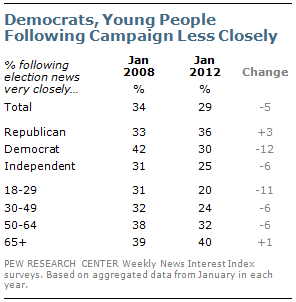
The 2012 presidential campaign is drawing significantly less interest than the 2008 campaign from Democrats and younger people. According to the Pew Research Center’s News Interest Index surveys over the course of January, 30% of Democrats have been following election news very closely, down from 42% in January 2008, during the primary contest between Barack Obama and Hillary Clinton. By contrast, Republican interest has changed little since 2008 (36% very closely now, 33% then).
The 2012 campaign also is attracting less interest from young people. So far this year, only 20% of people under age 30 have been following news about the campaign very closely. That compares with 31% four years ago. Interest is down slightly among those ages 30 to 64, and has held steady among older Americans. This year, people age 65 and older are twice as likely as those under 30 to be closely following the election (40% vs. 20%). Four years ago, there was only a small gap between the interest of younger and older Americans.
Campaign News Sources
The audiences for several traditional campaign news sources – including local television news, nightly network news and daily
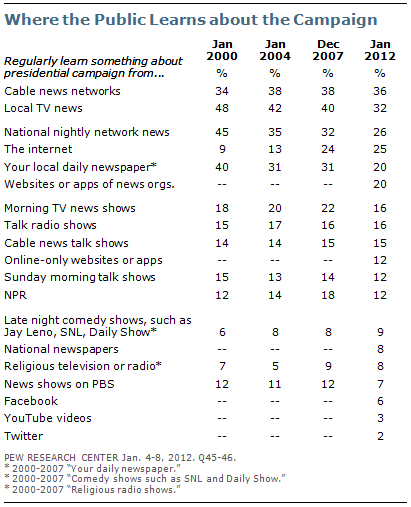
newspapers – fell between 2000 and 2004 but stabilized during the 2008 campaign, which attracted considerable public interest. The new survey finds further declines in the numbers saying they regularly get campaign news from these traditional sources.
Roughly a third (32%) say they regularly get campaign news from local television news, down from 40% four years ago. About a quarter (26%) say they regularly learn about the campaign from nightly network news, down six points since December 2007. And just 20% regularly get campaign news from local newspapers, compared with 31% who regularly learned something from their daily newspaper four years ago.
During the 2000 campaign, local television (48%), nightly network news (45%) and daily newspapers (40%) were the public’s leading regular sources for campaign news. At that time, the audiences for all three surpassed the number who regularly said they got campaign news from cable news networks.
Yet cable news has maintained its campaign news audience over the last dozen years and now ranks as the top regular source for campaign news and information. Currently, 36% say they regularly learn about the campaign from cable news networks, which is little changed from the three previous presidential campaigns.
A quarter of Americans (25%) say they regularly learn something about the campaign from the internet, which is virtually unchanged from 2008 (24%). Between 2000 and 2008, the number relying on the internet for campaign news increased from 9% to 24%.
When it comes to specific internet sources, relatively few say they are regularly learning about the campaign from Facebook (6%), YouTube videos (3%) or Twitter (2%). Instead, the more common sources of campaign news online are the websites or apps of television, radio, newspaper or magazine news organizations (20%) and online-only sites and apps (12%).
Young People Less Engaged
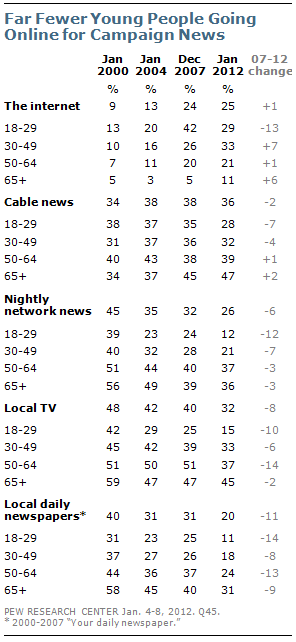
Reflecting their lack of interest in the 2012 campaign generally, young people are significantly less likely to say they are learning about the campaign from the internet than four years ago. Just 29% of those younger than 30 say they regularly learn about the candidates and campaigns online, compared with 42% early in the 2008 campaign. The web has grown as a source for those in older age groups, though not those ages 50 to 64.
The internet is not the only campaign news source that young people are using less. Compared with four years ago, half as many 18-to-29-year-olds regularly learn about the campaign from daily newspapers (11% down from 25%) and network evening news (12% down from 24%). Fewer young people also are getting campaign news from local television news.
Meanwhile, cable news has grown to be the top source partly by expanding its reach among older Americans. In 2000, barely a third (34%) of people age 65 and older said they regularly got campaign information from cable networks. That put cable far behind local television news (59%), daily newspapers (58%) and nightly network news (56%) among those in this age group.
Today, the share of Americans 65 and older who regularly get campaign information from cable networks has risen to 47%, which is on par with local television news (45%). Among those in this age group, 36% regularly get campaign news from nightly network news and 31% regularly learn about the campaign from daily newspapers (31%).
Age and News Sources
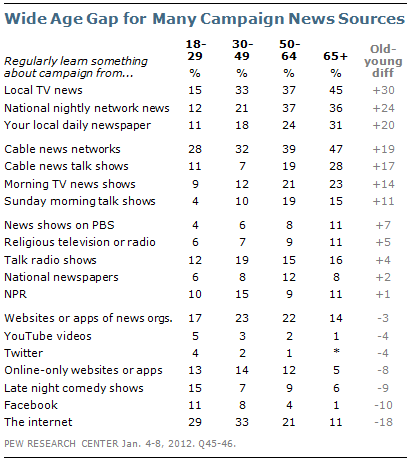
The top campaign news sources for those younger than 30 continue to be the internet and cable news networks. Still, only about three-in-ten regularly learn something about the campaign from these sources (29% internet, 28% cable).
The next most common sources for younger Americans are local television news and late night comedy shows, cited as regular sources of campaign information by 15% each. In fact, aside from the internet and other online sources, late night comedy shows are the only campaign news source tested that young people turn to more than older people.
People age 65 and older are three times as likely as those younger than 30 to regularly learn about the election from local television news (45% versus 15%) and nightly network news (36% versus 12%), and the gap is almost as large for local daily newspapers (31% versus 11%).
Social Networks and Campaign News
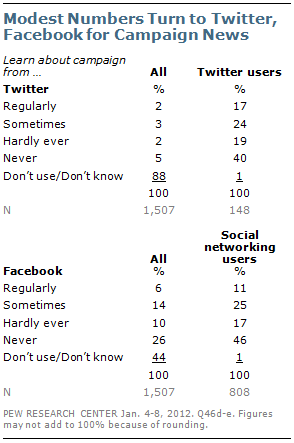
Very few Americans regularly learn about the campaign from Facebook (6%) or Twitter (2%). This partly reflects the fact that these social networks are not used at all by large numbers of Americans. But even among Twitter users, just 17% say they regularly learn about the presidential election from Twitter; another 24% say they sometimes learn about the campaign this way. Most Twitter users say they hardly ever (19%) or never (40%) learn about the election from Twitter.
Similarly, only about one-in-ten (11%) people who use social networking sites, such as Facebook, Google+ and LinkedIn, say they regularly learn about the campaign from Facebook and another quarter say they sometimes do. Almost half of social networkers (46%) say they never learn about the election there. Another 17% say they hardly ever learn about the campaign from Facebook.
Social networking plays a larger role for younger Americans. Among social network users under age 50, about 40% say they regularly or sometimes learn about the campaign from Facebook. Among social network users who are 50 and older, just 24% say the same.
Main Sources of Campaign News
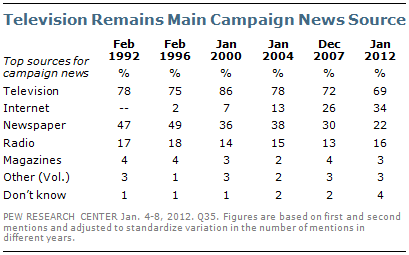
The survey includes a measure of where people get most of their news about the presidential election campaign, as well as asking about the news sources they regularly use.
As in past campaigns, a large majority (69%) cites television as a main source of campaign news. About a third (34%) cites the internet as a top campaign news source. For the first time, more Americans mention the internet than newspapers as a main campaign news source (34% vs. 22%). At about the same point four years ago, roughly equal numbers listed the internet (26%) and newspapers (30%) as their main campaign news source.
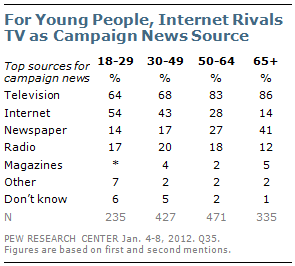
Nearly two-thirds (64%) of those younger than 30 say television is a top news source, and 54% say the same about the internet. The internet is the second most frequently named source for those 30 to 49. Among those 50 to 64, about as many say they get most of their campaign news from the internet (28%) as from newspapers (27%). Television is, far and away, the top source for those 65 and older (86%), followed by newspapers (41%). Far fewer (14%) say the internet is a top source, with about as many as citing radio (12%).
Partisan Cable Landscape
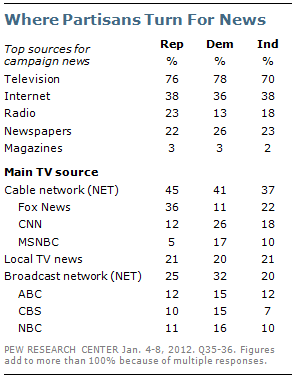
Cable television news is a main campaign news source for 45% of Republicans, 41% of Democrats and 37% of independents. But they turn to different cable networks. Republicans are far more likely to count on Fox News (36%) for campaign information than are Democrats (11%). Democrats are much more likely than Republicans to rely on CNN (26% vs. 12%) and MSNBC (17% vs. 5%).
Republicans and Republican-leaning independents who agree with the Tea Party are especially likely to rely on Fox News as a main television source of campaign news: 53% say they get most of their news about the election from Fox News, compared with just 26% of other Republicans and Republican leaners.
Top Online Sources for Campaign News
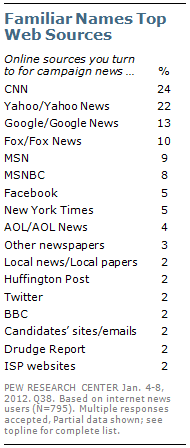
Those who get news online tend to rely on the websites or apps of news organizations and search engines or aggregators. Almost a quarter cite CNN (24%) and nearly as many (22%) point to Yahoo. Google (13%) and Fox also are popular (10%). Facebook was mentioned by 5% of internet news users, as many as cited the New York Times. Twitter was named by 2% of internet news users.
Young adults list many of the same sites as those who are older: Among those younger than 30 who use the internet to get news, CNN, Yahoo and Google are among their top online sources of campaign information. Facebook is offered by 8% of young people and Twitter by 4%.
Far more Republican internet news users (22%) than independents (7%) or Democrats (4%) say they turn to Fox News online for campaign news. Partisan differences in the numbers going to CNN and MSNBC are less dramatic. Three-in-ten (30%) Democratic internet news users cite CNN as a main source for campaign news, as do 22% of independents and 20% of Republicans. About one-in-ten Democrats (11%) and Republicans (9%) cite MSBNC, along with 5% of independents.




